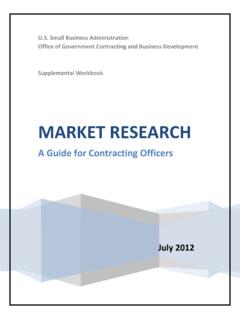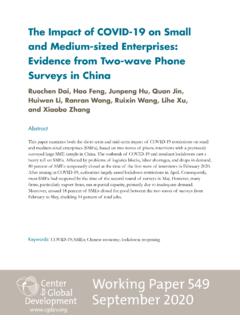Transcription of New Markets Tax Credit - IRS tax forms
1 Under no circumstances should the contents of this guide be used or cited as authority for setting or sustaining a technical position. IRS Department of the Treasury Internal Revenue Service LMSB-04-0510-016 (May 2010)Internal Revenue Service New Markets Tax Credit Internal Revenue Service Mission Provide America s taxpayers top quality service by helping them understand and meet their tax responsibilities and by applying the tax law with integrity and fairness to all. Department of the Treasury Internal Revenue Service Document Catalog Number Ten Core Ethical Principles * Honesty Integrity/Principled Promise-Keeping Loyalty Fairness Caring and Concern for Others Respect for Others Civic Duty Pursuit of Excellence Personal Responsibility/Accountability The Five Principles of Public Service Ethics * Public Interest Objective Judgment Accountability Democratic Leadership Respectability * Used by permission of the Michael and Edna Josephson Institute of Ethics LMSB-04-0510-016 (May 2010) iContents Chapter 1: Introduction to the New Markets Tax Credit 1.
2 Introduction 2. Congressional Intent 3. Taxpayer s Qualified Equity Investment (QEI) 4. Allowance of Credit 5. Relationship to Other Federal Tax Benefits 6. Anti Abuse Rules 7. Qualified Community Development Entity (CDE) 8. Community Development Financial Institutions Fund s Responsibilities 9. Internal Revenue Service s Responsibility 10. The Complete Picture 11. Summary Chapter 2: Issues at the CDE Level 1. Introduction 2. Pre-Contact Analysis of Tax Returns 3. Preliminary Analysis 4. Qualified Equity Investment (QEI) 5. Qualified Low-Income Community Investment (QLICI) 6. Qualified Active Low-Income Community businesses (QALICB) 7. Substantially-All Requirement under Treas. Reg. (c)(5) 8. Redemption of an Equity Investment by the CDE 9. Conclusion 10. Summary Chapter 3: Issues at the Investor Level 1.
3 Introduction 2. Current Year NMTC Adjustments 3. Annual Adjustment to Basis 4. Disposition of Investor s Holding 5. NMTC Recapture Events 6. Computing the Recapture Amount 7. Summary Chapter 4: Issues at the Exempt Organization Level 1. Introduction 2. EO s Role in the NMTC Program 3. EO Issues with Regard to the NMTC 4. Examination Procedures 5. Referral Procedures 6. Summary Chapter 5: Disclosure of Tax Information 1. Introduction 2. Authorized Disclosures 3. Summary 4. IRC 6103 Quick Reference Guide LMSB-04-0510-016 (May 2010) ii Chapter 6: Audit Reports 1. Introduction 2. CDE (Corporation) 3. CDE (Partnership) 4. Investors (Individuals and Corporations) 5. form 886, Explanation of Items 6. Summary LMSB-04-0510-016 (May 2010) 1 Chapter 1 Introduction to the New Markets Tax Credit Introduction This chapter provides a brief overview of the New Markets Tax Credit (NMTC) under IRC 45D.
4 Congressional Intent The New Markets Tax Credit (NMTC) Program, enacted by Congress as part of the Community Renewal Tax Relief Act of 2000, is incorporated as section 45D of the Internal Revenue Code. This Code section permits individual and corporate taxpayers to receive a Credit against federal income taxes for making Qualified Equity Investments (QEIs) in qualified community development entities (CDEs). These investments are expected to result in the creation of jobs and material improvement in the lives of residents of low-income communities. Examples of expected projects include financing small businesses , improving community facilities such as daycare centers, and increasing home ownership opportunities. A low-income community is defined as any population census tract where the poverty rate for such tract is at least 20% or in the case of a tract not located within a metropolitan area, median family income for such tract does not exceed 80 of statewide median family income, or in the case of a tract located within a metropolitan area, the median family income for such tract does not exceed 80% of the greater of statewide median family income or the metropolitan area median family income.
5 As part of the American Jobs Creation Act of 2004, IRC 45D(e)(2) was amended to provide that targeted populations may be treated as low-income communities. A targeted population means individuals, or an identifiable group of individuals, including an Indian tribe, who are low-income persons or otherwise lack adequate access to loans or equity investments. Targeted population also includes the Hurricane Katrina Gulf Opportunity (GO) Zone, where individuals principal residences or principal sources of income were located in areas that were flooded, sustained heavy damage, or sustained catastrophic damage as a result of Hurricane Katrina. See Notice 2006-60, [2006], 2006-2 82, for additional guidance on targeted populations. LMSB-04-0510-016 (May 2010) 2 Taxpayers Qualified Equity Investment (QEI) Qualified Equity Investment (QEI) Defined The actual cash investment made by the investor to the CDE, which is referred to as the equity investment, is the first step in defining a QEI.
6 This cash investment eventually qualifies for the NMTC provided that the CDE makes qualified low-income community investments (QLICIs). A QEI is, in general, any equity investment in a CDE if: 1. Such investment is acquired by the investor at its original issue (directly or through an underwriter) solely in exchange for cash, 2. Substantially all (at least 85%) of the cash is used by the CDE to make qualified low-income community investments (QLICI), and 3. The investment is designated by the CDE as a QEI on its books and records using any reasonable method. The term equity investment means any stock in an entity which is a corporation, and any capital interest in an entity which is a partnership. Amount Paid at Original Issue Under IRC 45D(b)(1)(A) and Treas. Reg. (b)(4), the amount paid by the investor to the CDE for a QEI at its original issue consists of all amounts paid by the taxpayer to, or on behalf of, the CDE and includes any underwriter fees to purchase the investment at its original issue.
7 Time of Investment In general, an equity investment in a CDE is not eligible to be designated as a QEI if it is made before the CDE enters into an allocation agreement with the Community Development Financial Institutions Fund (CDFI). The allocation agreement specifies the terms of the NMTC allocation under IRC 45D(f)(2). However, for exceptions to the rule, see Treas. Reg. (c)(3)(ii). Reporting Requirements A CDE must provide notice to any investor who acquires a QEI in the CDE at its original issue that the equity investment is a QEI entitling the investor to claim the NMTC. The notice is made using form 8874-A, Notice of Qualified Equity Investment for New Markets Credit , or for periods before March 2007, a written notification prepared by the CDE. The notice must be provided by the CDE to the taxpayer no later than 60 days after the date the investor makes the equity investment in the CDE.
8 The notice must contain the amount paid to the CDE for the QEI at its original issue and the CDE s taxpayer identification number. (Treas. Reg. (g)(2)(A).) Allocation Limitation The amount of QEIs designated by a CDE may not exceed the amount allocated to the CDE by the CDFI Fund. The term QEI does not include: 1. Any equity investment issued by a CDE more than 5 years after the CDE enters into an allocation agreement with the CDFI Fund, and 2. Any equity investment by a CDE in another CDE, if the CDE making the investment has received an allocation under IRC 45D(f)(2). This prevents a CDE with an allocation from investing in another CDE with an allocation, and LMSB-04-0510-016 (May 2010) 3thereby doubling up credits on a single investment. Allowance of Credit The NMTC is included under IRC 38(a)(13) as part of the General Business Credit .
9 The Credit equals 39% of the investment and is claimed during a seven-year Credit period. Investors may not redeem or otherwise case out their investments in the CDEs prior to the conclusion of the seven-year Credit period. Credit Allowance Date A taxpayer holding a qualified equity investment (QEI) on a Credit allowance date occurring during the taxable year may claim the NMTC for such taxable year in an amount equal to the applicable percentage of the amount paid to a qualified community development entity (CDE) for such investment at its original issue. Under IRC 45D(a)(3), the term Credit allowance date means, with respect to any QEI: 1. The date on which the investment is initially made; and 2. Each of the six anniversary dates of such date thereafter. In other words, the Credit period is the seven-year period beginning on the date a QEI is initially made, even though the Credit is allowable on the first day of each Credit year.
10 Applicable Percentage The Credit provided to the investor equals 39% of the QEI and is claimed over the seven-year Credit period. Under IRC 45D(a)(2), the applicable percentage is 5 percent for the first three Credit allowance dates and 6 percent for the last four Credit allowance dates. Example 1: A CDE receives a $2 million NMTC allocation. Investors make $2 million of equity investments in the CDE. Assuming all other requirements are met, the investors would be entitled to claim NMTC equal to 39% of $2 million or $780,000 as follows: Year One: 5% of $2 million = $100,000 Year Two: 5% of $2 million = $100,000 Year Three: 5% of $2 million = $100,000 Year Four: 6% of $2 million = $120,000 Year Five: 6% of $2 million = $120,000 Year Six: 6% of $2 million = $120,000 Year Seven: 6% of $2 million = $120,000 Total: $780,000 Although the CDE has the authority to designate up to $ 2 million in QEI, its investors can only claim the NMTC on the actual cash invested in the CDE.











